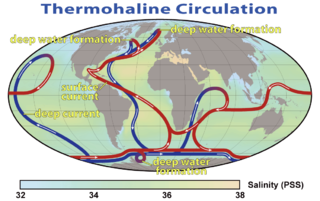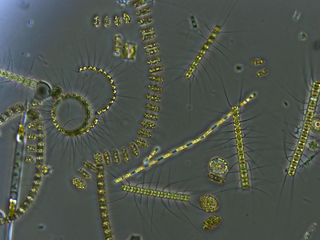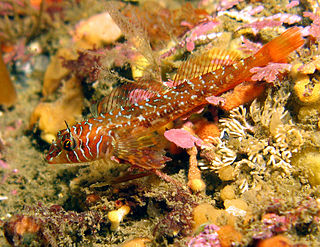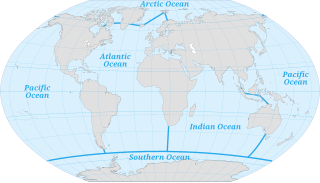
Marine biology is the scientific study of the biology of marine life, organisms in the sea. Given that in biology many phyla, families and genera have some species that live in the sea and others that live on land, marine biology classifies species based on the environment rather than on taxonomy.

Oceanography, also known as oceanology and ocean science, is the scientific study of the oceans. It is an important Earth science, which covers a wide range of topics, including ecosystem dynamics; ocean currents, waves, and geophysical fluid dynamics; plate tectonics and the geology of the sea floor; and fluxes of various chemical substances and physical properties within the ocean and across its boundaries. These diverse topics reflect multiple disciplines that oceanographers utilize to glean further knowledge of the world ocean, including astronomy, biology, chemistry, climatology, geography, geology, hydrology, meteorology and physics. Paleoceanography studies the history of the oceans in the geologic past. An oceanographer is a person who studies many matters concerned with oceans, including marine geology, physics, chemistry and biology.

Phytoplankton are the autotrophic (self-feeding) components of the plankton community and a key part of ocean and freshwater ecosystems. The name comes from the Greek words φυτόν, meaning 'plant', and πλαγκτός, meaning 'wanderer' or 'drifter'.

Fishery can mean either the enterprise of raising or harvesting fish and other aquatic life; or more commonly, the site where such enterprise takes place. Commercial fisheries include wild fisheries and fish farms, both in freshwater waterbodies and the oceans. About 500 million people worldwide are economically dependent on fisheries. 171 million tonnes of fish were produced in 2016, but overfishing is an increasing problem — causing declines in some populations.

An aquatic animal is any animal, whether invertebrate or vertebrate, that lives in water for most or all of its lifetime. Many insects such as mosquitoes, mayflies, dragonflies and caddisflies have aquatic larvae, with winged adults. Aquatic animals may breathe air or extract oxygen from water through specialised organs called gills, or directly through the skin. Natural environments and the animals that live in them can be categorized as aquatic (water) or terrestrial (land). This designation is polyphyletic.

An oceanic climate, also known as a marine climate, is the humid temperate climate sub-type in Köppen classification Cfb, typical of west coasts in higher middle latitudes of continents, generally featuring cool summers and mild winters, with a relatively narrow annual temperature range and few extremes of temperature. Oceanic climates can be found in both hemispheres generally between 40 and 55 latitude, most notably in Northwest Europe, Northwest North America, as well as New Zealand.

A salp or salpa is a barrel-shaped, planktic tunicate. It moves by contracting, thereby pumping water through its gelatinous body, one of the most efficient examples of jet propulsion in the animal kingdom. The salp strains the pumped water through its internal feeding filters, feeding on phytoplankton.

The effects of climate change span the impacts on physical environment, ecosystems and human societies due to human-caused climate change. The future impact of climate change depends on how much nations reduce greenhouse gas emissions and adapt to climate change. Effects that scientists predicted in the past—loss of sea ice, accelerated sea level rise and longer, more intense heat waves—are now occurring. The changes in climate are not uniform across the Earth. In particular, most land areas have warmed faster than most ocean areas, and the Arctic is warming faster than most other regions.. The regional changes vary: at high latitudes it is the average temperature that is increasing, while for the oceans and tropics it is in particular the rainfall and the water cycle where changes are observed. Global warming changes regional climate via the melting of ice, changes in the hydrological cycle and changing currents in the oceans.

Ocean acidification is the reduction in the pH of the Earth’s ocean. This process takes place over periods lasting decades or more. Its main cause is the absorption of carbon dioxide (CO2) from the atmosphere. This, in turn, increases CO2 concentrations in the ocean. Between 23 and 30% of the CO2 that is in the atmosphere dissolves into oceans, rivers and lakes. Acidification is one of several effects of rising CO2 on the ocean. Other chemical changes to the ocean can also cause acidification. As the ocean absorbs CO2, seawater chemistry changes, which changes the living conditions of marine species. Many different species are affected, especially organisms that rely on calcium carbonate shells and skeletons, like mollusks, oysters and corals. Organisms like these struggle to build those parts of their anatomy when ocean waters have increased acidity. Ocean acidification has occurred previously in Earth's history. The resulting ecological collapse in the oceans had long-lasting effects on the global carbon cycle and climate. The main solution to present-day ocean acidification lies in reducing atmospheric CO2 levels through climate change mitigation. Over 100 science academies have issued a statement on ocean acidification. The statement recommends that by 2050, global CO2 emissions be reduced by at least 50% compared to 1990 levels.

The ocean is the body of salt water that covers approximately 70.8% of the surface of Earth and contains 97% of Earth's water. An ocean can also refer to any of the large bodies of water into which the world ocean is conventionally divided. Separate names are used to identify five different areas of the ocean: Pacific, Atlantic, Indian, Southern (Antarctic), and Arctic. Seawater covers approximately 361,000,000 km2 (139,000,000 sq mi) of the planet. The ocean is the principal component of Earth's hydrosphere, and therefore integral to life on Earth. Acting as a huge heat reservoir, the ocean influences climate and weather patterns, the carbon cycle, and the water cycle.

The southern elephant seal is one of two species of elephant seals. It is the largest member of the clade Pinnipedia and the order Carnivora, as well as the largest extant marine mammal that is not a cetacean. It gets its name from its massive size and the large proboscis of the adult male, which is used to produce very loud roars, especially during the breeding season. A bull southern elephant seal is about 40% heavier than a male northern elephant seal, twice as heavy as a male walrus, and 6–7 times heavier than the largest living mostly-terrestrial carnivoran, the polar bear and the Kodiak bear ,.
The Future of Marine Animal Populations (FMAP) project was one of the core projects of the international Census of Marine Life (2000–2010). FMAP's mission was to describe and synthesize globally changing patterns of species abundance, distribution, and diversity, and to model the effects of fishing, climate change and other key variables on those patterns. This work was done across ocean realms and with an emphasis on understanding past changes and predicting future scenarios.

Climate change and fisheries affect one another, the relationship between these affects are backed by strong global evidence. Although these effects vary in the context of each fishery and the many pathways that climate change affects them individually. Rising ocean temperatures and ocean acidification are radically altering marine aquatic ecosystems, while freshwater ecosystems are being impacted by changes in water temperature, water flow, and fish habitat loss. Climate change is modifying fish distribution and the productivity of marine and freshwater species.

Hotspot Ecosystem Research and Man's Impact On European Seas (HERMIONE) is an international multidisciplinary project, started in April 2009, that studies deep-sea ecosystems. HERMIONE scientists study the distribution of hotspot ecosystems, how they function and how they interconnect, partially in the context of how these ecosystems are being affected by climate change and impacted by humans through overfishing, resource extraction, seabed installations and pollution. Major aims of the project are to understand how humans are affecting the deep-sea environment and to provide policy makers with accurate scientific information, enabling effective management strategies to protect deep sea ecosystems. The HERMIONE project is funded by the European Commission's Seventh Framework Programme, and is the successor to the HERMES project, which concluded in March 2009.
Bruce A. Menge is an American ocean ecologist. He has spent over forty years studying the processes that drive the dynamics of natural communities. His fields of interest include: structure and dynamics of marine meta-ecosystems, responses of coastal ecosystems to climate change, linking benthic and inner shelf pelagic communities, the relationship between scale and ecosystem dynamics, bottom-up and top-down control of community structure, recruitment dynamics, ecophysiology and sub-organismal mechanisms in environmental stress models, larval transport and connectivity, impact of ocean acidification on marine ecosystems, controls of productivity, population, community, and geographical ecology. He settled on two career goals: carrying out experiment-based field research to investigate the dynamics of rocky intertidal communities, focusing on species interactions and environmental context and how this might shape a community, and using the resulting data to test and modify theories on how communities were organized.

The effects of climate change on oceans include the rise in sea level from ocean warming and ice sheet melting, and changes in pH value, circulation, and stratification due to changing temperatures leading to changes in oxygen concentrations. There is clear evidence that the Earth is warming due to anthropogenic emissions of greenhouse gases and leading inevitably to ocean warming. The greenhouse gases taken up by the ocean help to mitigate climate change but lead to ocean acidification.

Nicholas Kevin Dulvy is a Distinguished Professor and Canada Research Chair in Marine Biodiversity and Conservation at Simon Fraser University. He was the Co-Chair of the International Union for Conservation of Nature (IUCN) Shark Specialist Group from 2009–2020. He has published more than 100 peer-reviewed papers and book chapters on life histories, extinction risk, the ecosystem impacts of fishing and the ecological and socioeconomic impacts of climate change.
Stephen R. Palumbi is the Jane and Marshall Steel Jr. Professor in Marine Sciences at Stanford University at Hopkins Marine Station. He also holds a Senior Fellowship at the Stanford Woods Institute for the Environment.
Alex D. Rogers is professor of conservation biology and fellow of Somerville College, University of Oxford.

Human activities affect marine life and marine habitats through overfishing, habitat loss, the introduction of invasive species, ocean pollution, ocean acidification and ocean warming. These impact marine ecosystems and food webs and may result in consequences as yet unrecognised for the biodiversity and continuation of marine life forms.















